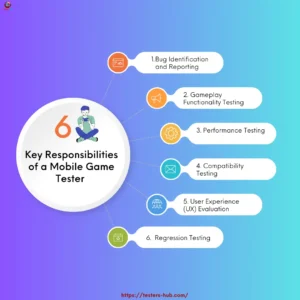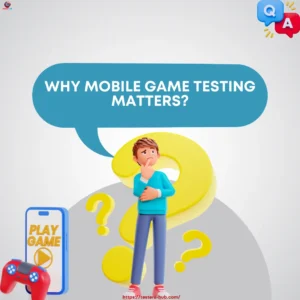How to Become a Professional Mobile Game Tester in 2024
Mobile game testing has become a crucial aspect of game development in today’s fast-paced digital world. As the gaming industry continues to grow, the demand for high-quality mobile games is greater than ever. Players expect flawless experiences, smooth gameplay, and immersive environments. The growing demand for high-quality games has led to a booming need for mobile game testers.
What Does a Mobile Game Tester Do?
A mobile game tester plays a vital role in ensuring that a game is free of bugs, glitches, and other technical issues before its release. The job involves testing games on various devices and platforms, and under different conditions to guarantee a seamless user experience. Mobile game testers identify flaws in gameplay mechanics, functionality, or performance and report these issues to the development team for correction.
Key Responsibilities of a Mobile Game Tester:
- Detecting Bugs and Issues: One of the main duties of a mobile game tester is identifying a variety of issues within the game, ranging from minor cosmetic glitches to significant bugs that disrupt gameplay or prevent progression. Testers must thoroughly explore different game features to ensure everything works as expected.
- Verifying Bug Fixes: After bugs are reported and fixed by the development team, testers must retest the game to ensure that the fix works as intended. They also check that no new issues are introduced in the process.
- Ensuring Cross-Device Compatibility: Testers are tasked with making sure the game functions correctly across various devices, operating systems, and screen sizes. This includes evaluating performance on both older and newer devices to ensure smooth gameplay for all users.
- Evaluating the User Experience (UX): Mobile game testers assess how easy and enjoyable the game is for users. They review the game’s interface, controls, and overall usability, providing feedback on how the game can be improved to offer a more seamless and enjoyable experience for players.
Different Types of Mobile Game Testing
Mobile game testing is a multifaceted process, with each test designed to evaluate a specific aspect of the game’s performance, usability, and stability. The following are some key testing types that help ensure the game provides an exceptional experience for users:
- Gameplay Functionality Verification: This test ensures that all in-game mechanics work as intended. From the responsiveness of character controls to the accuracy of game rules and logic, functionality testing verifies that the game behaves as expected under normal conditions. It ensures no critical features malfunction, and all menus, buttons, and interactions are fully functional.
- Device and OS Compatibility Evaluation: To maximize the reach of a mobile game, it must perform seamlessly across a variety of devices and operating systems. Compatibility testing checks whether the game is optimized for different screen sizes, resolutions, and versions of Android or iOS. It identifies any issues with how the game adjusts to diverse hardware and software environments, ensuring smooth gameplay for a wide range of players.
- Performance and Load Testing: Performance testing assesses how the game behaves under different conditions, such as how quickly it loads, whether there is any lag, and how responsive it is during gameplay.. This test ensures the game maintains consistent performance, even under challenging circumstances.
- Localization Testing: Localization testing guarantees that the game is suitable for various geographic regions and languages. This includes ensuring that the game’s text, voiceovers, graphics, and cultural references are appropriate for the local audience’s expectations and standards.
- Compliance Testing: Compliance testing guarantees that the game follows the criteria and rules established by app marketplaces like Google Play and Apple’s App Store. This involves adhering to technical standards, content restrictions, and privacy policies.
Read: The Difference Between Game QA Testing and Game Beta Testing
What is Mobile Game Testing and Why is it Crucial?
The Significance of Mobile Game Testing
Mobile game testing is an essential process aimed at assessing the quality and performance of a game before it is made available to the public. This process ensures the game is fully functional, free from technical issues, and provides a seamless experience for users. As the mobile gaming industry continues to experience rapid growth, the role of testing has become more important than ever.
Why Mobile Game Testing Matters
Mobile game testing serves several crucial purposes:
- Maintaining High Quality: Testing plays a vital role in identifying bugs, glitches, and other technical issues that could affect the gameplay. By catching these problems early, testers help ensure the game functions as intended, offering a high-quality experience for the users.
- Improving Player Satisfaction: Early detection and resolution of issues lead to a smoother gaming experience. A well-tested game helps keep players engaged, satisfied, and more likely to return, which in turn boosts user retention rates.
- Safeguarding the Brand’s Reputation: Games that are properly tested and bug-free tend to receive higher ratings and positive reviews on app stores. These good reviews are not only essential for the game’s success but also enhance the developer’s reputation, benefiting future game releases.
- Boosting Financial Success: A game that performs well and is free from errors is more likely to attract positive feedback. This leads to higher download numbers, more in-app purchases, and ultimately, greater revenue. Well-tested games have a higher chance of thriving financially in an increasingly competitive marketplace.
Read: The Best Game Testing Companies of 2024: Top Testing Partners for Developers
Key Elements of Mobile Game Testing
Key Aspects of Effective Mobile Game Testing
Effective mobile game testing focuses on several key factors to ensure the game delivers an optimal and seamless user experience. Let’s explore these essential elements:
- Device and Platform Compatibility To guarantee that the game works across a wide array of devices, testers must evaluate it on various screen sizes, hardware configurations, and operating systems. This includes testing the game on both iOS and Android platforms, ensuring compatibility across different OS versions to ensure broad accessibility and performance.
- Touchscreen Functionality As mobile games often rely on touch gestures like swipes, taps, and pinches for gameplay, testers must verify that the game responds accurately and consistently to user inputs. This includes testing the touch sensitivity and responsiveness across a range of devices to confirm smooth interaction.
- Network Performance For games that require an internet connection, especially those with multiplayer features, it’s crucial to assess how well the game performs under different network conditions. Testers examine how the game reacts to variations in network quality, such as 3G, 4G, and Wi-Fi, ensuring there are no issues like lag, interruptions, or connection drops that could impact the player’s experience.
Crucial Factors in Mobile Game Testing
- Battery Optimization Mobile games that consume excessive battery life are likely to leave users dissatisfied. Game testers examine how efficiently a game uses the device’s battery, particularly for those with high-quality graphics or demanding gameplay. Ensuring battery optimization is essential for a positive user experience, preventing rapid depletion during gameplay.
- Utilization of Device-Specific Features Many mobile games incorporate device features like GPS, cameras, or motion sensors to improve gameplay. Testers ensure these features are functioning properly, verifying their integration into the game does not cause malfunctions and enriches the overall user experience.
- Design for Small Screens Since mobile devices have relatively small screens, it’s crucial for the game’s interface to be designed appropriately. The goal is to ensure the interface is both functional and user-friendly, even on compact screens.
- Adapting Content for Global Audiences For games being distributed internationally, testers perform localization checks to ensure that all in-game content, such as text, cultural references, and visual elements, are tailored to different languages and cultural norms. This ensures that players from various regions feel the game was specifically designed for them.
- Ensuring Game Security For mobile games that include online functionalities, such as multiplayer modes or in-app purchases, security testing is a must. Testers verify that the game is safe from external threats and ensure that players’ personal and financial information is kept secure. This process ensures that the game does not expose players to privacy risks.
Common Bugs in Mobile Game Testing
Game testers often encounter a variety of bugs during the testing process. Some of the most common types of bugs include:
- Interface Bugs: These include issues like overlapping text, misaligned buttons, or incorrect icon sizes that negatively affect the player’s experience.
- Technical Bugs: These are crashes, freezes, and glitches in gameplay or menus that disrupt the gaming experience.
- Localization Bugs: Mistakes in translation or cultural references that make the game confusing or inappropriate for certain audiences.
- Performance Bugs: These are related to poor frame rates, lag, and stuttering during gameplay.
- Compatibility Bugs: These bugs arise when the game doesn’t perform well on certain devices, screen sizes, or OS versions.
- Balance and Logic Bugs: These bugs occur when the game is too easy or too hard, or when mechanics don’t work logically.
Challenges Faced by Mobile Game Testers
Mobile game testing is not without its challenges. Some of the most common obstacles testers face include:
Device Fragmentation: Testers must manage a variety of devices, screen sizes, and OS versions.
Multiplayer Testing: Simulating multiplayer gameplay across locations and time zones can be complex.
Social Media Integration: Testers ensure social media features don’t disrupt gameplay.
Game Engine Complexity: Games built with complex engines like Unity or Unreal require specialized knowledge for effective testing.
Best Practices for Mobile Game Testing
- Cross-Device and OS Testing
For a consistent gaming experience, it is important to test the game across various devices, operating systems, and screen sizes. This ensures that the game functions smoothly, regardless of the device a user is playing on. - Real Device Testing
While simulators and emulators provide a quick way to test, using actual devices is critical for identifying issues that might not be visible in virtual environments. Testing on real hardware allows testers to check the actual performance, screen touch accuracy, and device-specific compatibility. - Automated Testing for Repetitive Tasks
Incorporating automation into the testing process can streamline repetitive testing activities and handle large-scale testing more efficiently. Automation is particularly useful in scenarios like stress testing or validating game features that need to be tested multiple times, freeing up resources for other critical testing areas. - Continuous Testing Through Development
Testing shouldn’t be confined to the final stages of game development. It’s essential to integrate regular testing throughout the entire development cycle to identify issues early, allowing developers to make adjustments as the game evolves.
Read: Why You Should Partner with a Game Testing Companies
Mobile Game Testing Tools
There are several tools available to help game testers automate the testing process, monitor performance, and ensure high-quality results:
Unity Test Tools: Designed for Unity games, it allows automated testing within the Unity environment.
Appium: A versatile tool for testing native and hybrid apps on iOS and Android.
TestFlight: An iOS beta testing platform to gather feedback before release.
Google Play Console Pre-launch Report: Tests Android games across devices, providing performance, security, and usability reports.
Selenium: Mainly for web apps, but useful for testing mobile web games and hybrid game components.
Conclusion
Mobile game testing is critical in ensuring that games fit the needs of today’s mobile gamers. As a mobile game tester, you’ll ensure games are bug-free, work well across platforms, and offer an engaging experience. By understanding different testing types, and key factors, and using the right tools, you can greatly impact a game’s success. The demand for skilled testers in the gaming industry is growing, whether you’re just starting or looking to enhance your skills. By learning mobile game testing, you may help creators deliver high-quality games that please players all over the world.












